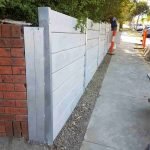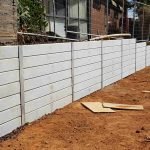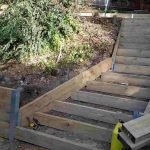Introduction
When it comes to enhancing your landscape, a sturdy and visually pleasing maintaining wall can make all the difference. Whether you're seeking to prevent soil erosion, produce a flat space in an uneven area, or just add visual interest your home, employing the ideal retaining wall contractor is essential. This guide will walk you through whatever you require to know about finding, evaluating, and hiring an expert retaining wall installer.
What Is a Retaining Wall Contractor?
A retaining wall contractor concentrates on the style and construction of maintaining walls. These professionals comprehend numerous products-- like concrete sleepers, H beams, wood sleepers, lumber sleepers, and stone-- and how to successfully use them for developing resilient structures that serve both functional and visual purposes.
Why You Required a Retaining Wall Contractor
Expertise: An experienced specialist brings important knowledge about soil types, drainage options, and design concepts that make sure the wall's longevity.
Quality Materials: They have access to high-quality products that may not be easily available to the average homeowner.
Regulations: Specialist specialists are skilled in regional building codes and zoning laws.
The Advantages of Employing a Professional Retaining Wall Builder
Hiring an expert retaining wall builder has several benefits:
- Safety: Constructing walls requires an understanding of structural stability; experts decrease risks. Time-Efficient: Professionals can finish jobs much faster due to their experience and expertise. Warranty Options: Lots of professionals offer guarantees on their work, offering comfort for homeowners.
Types of Keeping Walls
Understanding the various kinds of retaining walls can assist you choose what finest fits your requirements:
1. Concrete Sleeper Walls
Concrete sleeper walls are upraised concrete panels that provide exceptional durability and strength.
2. H Beam Walls
H beam walls make use of steel beams for added assistance and are perfect for bigger structures.
3. Wood Sleeper Walls
These are more aesthetically pleasing but might require more upkeep gradually compared to concrete options.
4. Timber Sleeper Walls
Timber offers a natural appearance however is susceptible to rot if not dealt with properly.
5. Stone Walls
Stone is frequently utilized for its beauty but requires proficient labor for installation.
How to Pick the Right Retaining Wall Installer
Choosing the right retaining wall installer includes a number of actions:
1. Research Professionals in Your Area
Start by browsing online or asking next-door neighbors for suggestions. Try to find evaluations on platforms like Yelp or Google My Business.
2. Examine Their Experience
It's essential to ask possible professionals about their experience particularly with retaining walls.

3. Check Licensing and Insurance
Always validate that the specialist is certified and guaranteed; this safeguards you in case of accidents during construction.
4. Request for References
A credible contractor should have the ability to supply recommendations from past clients who had similar projects completed.
Questions You Ought to Ask Before Hiring
Before deciding, prepare questions that will offer you insights into their skills:
What is your experience with building keeping walls? Can I see examples of your previous work? How do you handle drain issues? What products do you advise based on my task needs? How long will my job draw from start to finish? Do you supply warranties or assurances on your work?Understanding Costs Associated with Structure Maintaining Walls
The expense of constructing a retaining wall can differ substantially based on several elements:
- Material type (e.g., concrete vs wood) Wall height Site accessibility Labor rates
Here's an approximated breakdown of costs by material type:
|Product Type|Cost per Square Foot|| --------------------|----------------------|| Concrete Sleeper|$30 - $50|| H Beam|$25 - $45|| Wood Sleeper|$15 - $30|| Timber Sleeper|$20 - $35|| Stone|$50 - $100|
The Necessary Guide to Employing a Retaining Wall Contractor: The Preparation Phase
Proper planning can save you time and money down the line when working with your picked contractor:
1. Evaluate Your Needs
Consider why you require a maintaining wall-- whether it's disintegration control, developing usable land, or https://penzu.com/p/155968f9a843af79 aesthetic enhancement.
2. Measure Your Space
Accurate measurements ensure that the style satisfies your needs while sticking to regional regulations.
3. Set a Budget
Understanding what you're willing to spend assists narrow down alternatives when talking about materials and designs with contractors.

Design Considerations When Employing a Retaining Wall Contractor
Design isn't almost looks; it must likewise serve practical purposes:
1) Height
How tall do you require the wall? Taller walls may need additional engineering considerations.

2) Drainage
Water management is essential; incorrect drain services can result in structural failure over time.
3) Aesthetic Appeal
Consider incorporating landscaping components such as plants or decorative stones into the design for visual appeal.
Legal Considerations When Developing a Retaining Wall
Many areas have specific regulations regarding building and construction projects:
1) Regional Zoning Laws: Inspect if permits are needed before beginning construction.
2) Property Lines: Make sure that your new structure does not trespass on neighboring properties.
3) Ecological Regulations: Some regions have guidelines relating to landscaping near water bodies or safeguarded areas.
FAQs About Working with A Retaining Wall Contractor
Here are some typical questions individuals have about working with a retaining wall contractor together with concise responses:
1) How long does it require to develop a maintaining wall?
The timeline varies based on size and complexity however typically ranges from one day for little walls up to several weeks for bigger installations requiring heavy machinery or comprehensive site preparation.
2) Do I require permits for building a maintaining wall?
Most municipalities require licenses for constructing taller than 4 feet; always check regional policies before proceeding with construction.
3) Can I develop my own keeping wall?
While DIY jobs are possible, it's advisable just if you're experienced in landscaping; employing professionals guarantees appropriate setup techniques are followed.
4) What products last longest?
Concrete sleeper walls typically last longer than wood choices due to their resistance versus decay; nevertheless, stone uses both toughness and beauty if installed correctly.
5) How do I preserve my new keeping wall?
Regular inspections will help recognize any issues early on; cleansing debris buildup guarantees effective drainage while monitoring fractures keeps them from intensifying over time.
6) Will my garden suffer during construction?
Most trusted contractors take safety measures not only throughout installation however likewise afterward by bring back impacted landscaping functions post-construction completion!
Conclusion
Finding the ideal retaining wall contractor does not have to be an overwhelming process if you're equipped with understanding about what they do and how they operate! The Essential Guide to Employing a Retaining Wall Contractor has offered insights into numerous aspects-- from comprehending kinds of walls available through examining costs involved-- all targeted at assisting homeowners make notified decisions when purchasing these critical outdoor structures! Constantly keep in mind-- when it comes down to protecting your residential or commercial property against soil erosion while likewise enhancing its visual appeal-- choosing wisely matters!